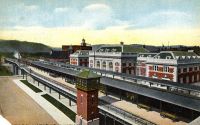B&O Building
 Wheeling's B&O Passenger Train Station
Wheeling's B&O Passenger Train Station
The Alumni Association has acted as historian for the College, working to preserve the history of the buildings occupied by the college and the relationship of those edifices to the community. The Alumni’s museum, established in 1985, has preserved and maintained a large collection of B&O memorabilia, 1,000 pieces of Hazel Atlas Glass and a small collection of Viking Glass manufactured in the New Martinsville area. As active members of the West Virginia Association of Museum, several Board members have received training in methods for the preservation and maintenance of collections, cataloging and exhibit techniques and standards for museum operation for the past fifteen years. The Museum Committee continues to organize exhibits throughout the year, offering the opportunity for students and the community at large to discover much of the B&O Railroad history and the B&O Building itself.
The following story about the recent celebration of the 100th anniversary of the B&O Building, held in September, 2008.
The B&O Passenger Station/WV Northern Community College
1908-2008
The B&O Railroad arrived in Wheeling in 1853. The first passenger station was located on the banks of the Ohio River near the mouth of Big Wheeling Creek. As the volume of both passenger and freight traffic grew, a larger facility was required. Construction on the French Renaissance building, that now is the home of West Virginia Northern Community College, was begun in 1906. A major river flood in 1907 delayed progress on the project and the building was not completed until 1908. The doors were opened to the public on September 3, 1908.
The newly opened facility was state-of-the-art – in fact, it was well ahead of the times with its own internal telephone system, steam heat, indoor plumbing and electric elevators. Electricity for the station was generated, utilizing steam, across Chapline Street on the site near the current Ohio County Library. A description of the interior of the building included in the B&O Blue Book reports an elegant, two-story lobby featuring a colored glass dome in the ceiling’s center that was lighted by sky-lights from the 4th floor roof. Marble floors and marble wainscot, brass and wrought iron chandeliers and sconces, scarlet walls, oak trim, and cast iron stairwells further enhanced the décor.
Because the immediate area surrounding the building was frequently flooded, the train tracks were located on an elevated trestle adjacent to the second floor of the building. Passengers purchased tickets in the lobby and then excited the back of the building, ascending to the upper deck to board the trains.
Passenger service from the Wheeling Station ceased in 1962. The building was sold to a private owner in the late 1960s and many local residents recall visiting the Blue Caboose, a poplar bar located on the 4th floor of the building during that period. In 1975, the State decided to purchase the building for the rapidly growing community college, opening the facility for educational purposes in 1976. Over the past thirty years, several renovations have enhanced the facility including the addition of the plaza on 16th Street and, more recently, the plaza on the back of the building after the train viaduct was removed. With each successive remodeling process, this beautiful building has become an increasingly important part of the historic adaptive-restoration efforts on-going in the down-town Wheeling area.
The college’s Alumni Association has devoted the past twenty-five years to preserving the history of the building and the impact of the B&O railroad on the immediate area. With the latest renovations, space has been provided to allow several items from the Alumni’s collection to remain on permanent display. Visitors from all over frequently stop in to tour the building, recognizing its value and historical significance. Local residents are invited to visit and discover this wonderful heritage.
© All Rights Reserved. 2008-09 J. D. Weiskircher.
